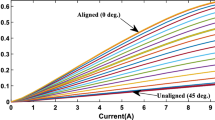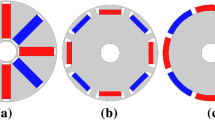Abstract
It is a challenging work to design high precision/high performance motion controller for permanent magnet synchronous motor (PMSM) due to some difficulties, such as varying operating conditions, parametric uncertainties and external disturbances. In order to improve tracking control performance of PMSM, this paper proposes an adaptive fuzzy robust control (AFRC) algorithm with smooth inverse based dead-zone compensation. Instead of nonsmooth dead-zone inverse which would cause the possible control signal chattering phenomenon, a new smooth dead-zone inverse is proposed for non-symmetric dead-zone compensation in PMSM system. AFRC controller is synthesized by combining backstepping technique and small gain theorem. Discontinuous projectionbased parameter adaptive law is used to estimate unknown system parameters. The Takagi-Sugeno fuzzy logic systems are employed to approximate the unstructured dynamics. Robust control law ensures the robustness of closed loop control system. The proposed AFRC algorithm with smooth inverse based dead-zone compensation is verified on a practical PMSM control system. The comparative experimental results indicate that the smooth inverse for non-symmetric dead-zone nonlinearity can effectively avoid the chattering phenomenon which would be caused by nonsmooth dead-zone inverse, and the proposed control strategy can improve the PMSM output tracking performance.
Similar content being viewed by others
References
H. X. Liu and S. H. Li, “Speed control for PMSM servo system using predictive functional control and extended state observer,” IEEE Trans. on Industrial Electronics, vol. 59, no. 2, pp. 1171–1183, February 2012. [click]
M. Rashed, P. F. A. MacConnell, A. F. Stronach, and P. Acarnley, “Sensorless indirect-rotor-field-orientation speed control of a permanent-magnet synchronous motor with stator-resistance estimation,” IEEE Trans. on Industrial Electronics, vol. 54, no. 3, pp. 1664–1675, June 2007. [click]
H. G. Li, C. F. Li, R. J. Zhao, D. L. Liu, and H. H. Zhu, “Analysis of the sensorless PMSM control technique in the full speed section,” Applied Mechanics and Materials, vol. 672, pp. 1191–1196, November 2014. [click]
Y. S. Kung and M. H. Tsai, “FPGA-based speed control IC for PMSM drive with adaptive fuzzy control,” IEEE Trans. on Power Electronics, vol. 22, no. 6, pp. 2476–2486, November 2007. [click]
L. Zhong, M. F. Rahman,W. Y. Hu, and K.W. Lim, “Analysis of direct torque control in permanent magnet synchronous motor drives,” IEEE Trans. on Power Electronics, vol. 12, no. 3, pp. 528–536, May 1997. [click]
C. Ortega, A. Arias, C. Caruana, J. Balcells, and G. M. Asher, “Improved waveform quality in the direct torque control of matrix-converter-fed PMSM drives,” IEEE Trans. on Industrial Electronics, vol. 57, no. 6, pp. 2101–2110, June 2010. [click]
C. L. Xia, J. X. Zhao, Y. Yan, and T. N. Shi, “A novel direct torque control of matrix converter-fed PMSM drives using duty cycle control for torque ripple reduction,” IEEE Trans. on Industrial Electronics, vol. 61, no. 6, pp. 2700–2713, June 2014. [click]
K. Gulez, A. A. Adam, and H. Pastaci, “A novel direct torque control algorithm for IPMSM with minimum harmonics and torque ripples,” IEEE/ASME Trans. on Mechatronics, vol. 12, no. 2, pp. 223–227, April 2007. [click]
T. Orlowska-Kowalska and M. Dybkowski, “Statorcurrent-based MRAS estimator for a wide range speedsensorless induction-motor drive,” IEEE Trans. on Industrial Electronics, vol. 57, no. 4, pp. 1296–1308, April 2010. [click]
M. Morawiec, “The adaptive backstepping control of permanent magnet synchronous motor supplied by current source inverter,” IEEE Trans. on Industrial Informatics, vol. 9, no. 2, pp. 1047–1055, May 2013. [click]
Z. Chen, B. Yao, and Q. Wang, “Accurate motion control of linear motors with adaptive robust compensation of nonlinear electromagnetic field effect,” IEEE/ASME Trans. on Mechatronics, vol. 18, no. 3, pp. 1122–1129, June 2013. [click]
Y.-R. Mohamed, “Adaptive self-tuning speed control for permanent magnet synchronous motor drive with dead time,” IEEE Trans. on Energy Conversion, vol. 21, no. 4, pp. 855–862, December 2006. [click]
C. H. Lin, “Novel adaptive recurrent Legendre neural network control for PMSM servo-drive electric scooter,” Journal of Dynamic Systems, Measurement, and Control, vol. 137, no. 1, 011010, August 2014. [click]
Y. S. Yang and J. S. Ren, “Adaptive fuzzy robust tracking controller design via small gain approach and its application,” IEEE Trans. on Fuzzy Systems, vol. 11, no. 6, pp. 783–795, December 2003. [click]
B. B. Ren, S. S. Ge, K. P. Tee, and T. H. Lee, “Adaptive neural control for output feedback nonlinear systems using a barrier Lyapunov function,” IEEE Trans. on Neural Networks, vol. 21, no. 8, pp. 1339–1345, August 2010. [click]
D. Saifia, M. Chadli, S. Labiod, and T. M. Guerra, “Robust H ∞ static output feedback stabilization of TS fuzzy systems subject to actuator saturation,” International Journal of Control, Automation and Systems, vol. 10, no. 3, pp. 613–622, Jun 2012. [click]
H. C. Sung, J. B. Park, and Y. H. Joo, “Observer-based sampled-data control for nonlinear systems: Robust intelligent digital redesign approach,” International Journal of Control, Automation and Systems, vol. 12, no. 3 pp. 486–496, May 2014. [click]
S. Barkat, A. Tlemçani, and H. Nouri, “Noninteracting adaptive control of PMSM using interval type-2 fuzzy logic systems,” IEEE Trans. on Fuzzy Systems, vol. 19, no. 5, pp. 925–936, October 2011. [click]
C. H. Lin, “Hybrid recurrent wavelet neural network control of PMSM servo-drive system for electric scooter,” International Journal of Control, Automation and Systems vol. 12, no. 1 pp. 177–187, February 2014. [click]
F. El-Sousy, “Robust wavelet-neural-network sliding-mode control system for permanent magnet synchronous motor drive,” IET Electric Power Applications, vol. 5, no. 1, pp. 113–132, January 2011. [click]
J. Na, X. M. Ren, G. Herrmann, and Z. Qiao, “Adaptive neural dynamic surface control for servo systems with unknown dead-zone,” Control Engineering Practice, vol. 19, no. 11, pp. 1328–1343, November 2011. [click]
J. Zhou, C.Wen, and Y. Zhang, “Adaptive output control of nonlinear systems with uncertain dead-zone nonlinearity,” IEEE Trans. on Automatic Control, vol. 51, no. 3, pp. 504–511, March 2006. [click]
T. P. Zhang and S. S. Ge, “Adaptive dynamic surface control of nonlinear systems with unknown dead zone in pure feedback form,” Automatica, vol. 44, no. 7, pp. 1895–1903, July 2008.[click]
C. X. Hu, B. Yao, and Q. F. Wang, “Adaptive robust precision motion control of systems with unknown input deadzones: a case study with comparative experiments,” IEEE Trans. on Industrial Electronics, vol. 58, no. 6, pp. 2454–2464, June 2011. [click]
G. Tao and P. V. Kokotovic, “Adaptive control of plants with unknown dead-zones,” IEEE Trans. on Automatic Control, vol. 39, no. 1, pp. 59–68, 1994. [click]
Q. K. Shen and T. P. Zhang, “Adaptive variable structure control for large scale time-delayed systems with unknown nonlinear dead-zone,” Journal of Systems Engineering and Electronics, vol. 18, no. 4, pp. 865–870, December 2007. [click]
H. J. Ma and G. H. Yang, “Adaptive output control of uncertain nonlinear systems with non-symmetric dead-zone input,” Automatica, vol. 46, no. 2, pp. 413–420, February 2010. [click]
S. C. Tong and Y. M. Li, “Adaptive fuzzy output feedback tracking backstepping control of strict-feedback nonlinear systems with unknown dead zones,” IEEE Trans. on Fuzzy Systems, vol. 20, no. 1, pp. 168–180, February 2012. [click]
S. C. Tong and Y. M. Li, “Adaptive fuzzy output feedback control of MIMO nonlinear systems with unknown deadzone inputs,” IEEE Trans. on Fuzzy Systems, vol. 21, no. 1, pp. 134–146, February 2013. [click]
Y. J. Liu and S. C. Tong, “Adaptive NN tracking control of uncertain nonlinear discrete-time systems with nonaffine dead-Zone input,” IEEE Trans. on Cybernetics, vol. 45, no. 3, pp. 497–505, March 2015. [click]
M. L. Corradini and G. Orlando, “Robust practical stabilization of nonlinear uncertain plants with input and output nonsmooth nonlinearities,” IEEE Trans. on Control Systems Technology, vol. 11, no. 2, pp. 196–203, March 2003. [click]
M. L. Corradini, G. Orlando, and G. Parlangeli, “A VSC approach for the robust stabilization of nonlinear plants with uncertain nonsmooth actuator nonlinearities-a unified framework,” IEEE Trans. on Automatic Control, vol. 49, no. 5, pp. 807–813, May 2004. [click]
S. Ibrir, W. F. Xie, and C. Y. Su, “Adaptive tracking of nonlinear systems with non-symmetric dead-zone input,” Automatica, vol. 43, pp. 522–530, March 2007. [click]
B. Yao and M. Tomizuka, “Adaptive robust control of SISO nonlinear systems in a semi-strict feedback form,” Automatica, vol. 33, no. 5, pp. 893–900, May 1997. [click]
B. Yao and M. Tomizuka, “Adaptive robust control of MIMO nonlinear systems in semi-strict feedback forms,” Automatica, vol. 37, no. 9, pp. 1305–1321, September 2001. [click]
Y. S. Yang and C. J. Zhou, “Adaptive fuzzy H ∞ stabilization for strict-feedback canonical nonlinear systems via backstepping and small gain approach,” IEEE Trans. on Fuzzy Systems, vol. 13, no. 1, pp. 104–114, February 2005. [click]
H. Chaoui and P. Sicard, “Adaptive fuzzy logic control of permanent magnet synchronous machines with nonlinear friction,” IEEE Trans. on Industrial Electronics, vol. 59, no. 2, pp. 1123–1133, February 2012. [click]
T. Takagi and M. Sugeno, “Fuzzy identification of systems and its applications to modeling and control,” IEEE Trans. on Systems, Man, and Cybernetics, vol. 15, no. 1, pp. 116–132, January-February 1985. [click]
L. Wang, A Course in Fuzzy Systems and Control, Prentice-Hall, New York, 1997.
E. D. Sontag, “Smooth stabilization implies coprime factorization,” IEEE Trans. on Automatic Control, vol. 34, no. 4, pp. 435–443, April 1989. [click]
E. D. Sontag, “Further facts about input to state stabilization,” IEEE Trans. on Automatic Control, vol. 35, no. 4, pp. 473–476, April 1990. [click]
Author information
Authors and Affiliations
Corresponding author
Additional information
Recommended by Associate Editor Sung Jin Yoo under the direction of Editor Euntai Kim. This work was supported by the National Natural Science Foundation of China under Grant No. 51305011, National Basic Research Program of China (973 Program) under Grant No. 2014CB046402 and the Fundamental Research Funds for the Central Universities under Grant No. YWF-14-FGC-016, YWF-13-T-RSC-064.
Xingjian Wang received the Ph.D. and B.Eng. degrees in mechatronics engineering from Beihang University, China, in 2012 and 2006. From 2009 to 2010, he was a visiting scholar in the School of Mechanical Engineering, Purdue University, West Lafayette, IN, U.S.. He is currently with the School of Automation Science and Electrical Engineering, Beihang University, Beijing, China. His research interests include adaptive and nonlinear control, fault diagnostic, prognostic and health management, active fault tolerant control.
Shaoping Wang received the Ph.D., M.Eng. and B.Eng. degrees in mechatronics engineering from Beihang University, China, in 1994, 1991 and 1988. She has been with the Automation Science and Electrical Engineering at Beihang University since 1994 and promoted to the rank of professor in 2000. She was honoured as a "Changjiang Scholar Professor" by the Ministry of Education of China in 2013. Her research interests include engineering reliability, fault diagnostic, prognostic and health management, active fault tolerant control.
Rights and permissions
About this article
Cite this article
Wang, X., Wang, S. Adaptive fuzzy robust control of PMSM with smooth inverse based dead-zone compensation. Int. J. Control Autom. Syst. 14, 378–388 (2016). https://doi.org/10.1007/s12555-015-0010-6
Received:
Revised:
Accepted:
Published:
Issue Date:
DOI: https://doi.org/10.1007/s12555-015-0010-6




